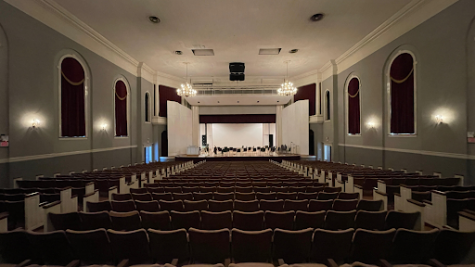Open campuses: An opening for crime?
It was the dead of night when he felt the cold barrel of a gun press against the top of his forehead. The young man looked around for help. The normally bustling cafe across the street was eerily still—it had closed nearly six hours ago at 10 p.m.
The man was a student at Ohio State, who was robbed at gunpoint at 2:30 a.m. on Aug. 23, according to The Columbus Dispatch. In that same week, four other major crimes—either robbery or assault—were committed, all on the open campus of Ohio State University. Like Ohio State, Guilford College is an open campus. These campuses are open to the public, and students can venture outside the campus (to local restaurants or other places) at their own discretion.
An open campus can be beneficial to colleges and universities as well as the general public. With an open campus, Guilford does not have to spend as much money creating and enforcing barriers that separate the campus and public land, while the public can take advantage of the scenic lake trails or the shade of oak trees in the picturesque quad. On some campuses, the general public can even access food courts like the one in UNCG’s Elliott University Center.
Unfortunately, an open campus leaves the College more vulnerable to outsiders, including those who may pose a threat. Although the chance of criminal activity occurring on campus in broad daylight is relatively low, chances begin to rise as the sun begins to dip. At Guilford, the area near the East Apartments is the most concerning.
“It’s very hard to do our job. (The East Apartments) are down there at the lake in the woods. Now you have to say, ‘where are your resources?’ The depth of those woods are very concerning. But I do know that there are barriers down there,” said Jermaine Thomas, Guilford College’s director of security.
In 2019, Guilford College reported 141 crime and safety-related incidents on campus or near campus, according to College Factual, which collects data on colleges and universities and offers various rankings at collegefactual.com. Collegefactual.com indicates that 3,990 colleges and universities reported crime and safety data in 2019, with 3,451 reporting fewer such incidents than Guilford.
“Based on a student body of 1,576 that works out to about 89.47 reports per thousand students” at Guilford, according to collegefactual.com. “In 2019, 3,831 colleges and universities reported fewer incidents per thousand students than did Guilford.”
However, the website states that a lack of reporting of crime and safety-related incidents is not uncommon among schools. “Nearly 1/3 of the colleges we analyzed either did not report crime or reported no incidents of crime. Zero incidents of reported crime may be nice to see, but it does not necessarily mean the school is safer….Higher incidents of reported crime could mean the school is stricter about law enforcement and reporting.”
As quoted in The Columbus Dispatch, Jim Moore, a spokesperson for the U.S. Department of Education, supports this view, acknowledging that crimes are underreported by certain schools to “protect their image.”
However, some Guilford students aren’t concerned with crimes occurring on campus at all. On Sept. 9, one traditional Guilford College student remarked that they aren’t concerned with crimes at all, because they didn’t notice any suspicious activity on campus.
Nevertheless, the Guilford security team has devised a wide variety of methods to reduce crime in and near the campus. Thomas pointed to the Greensboro police as a resource for gathering information, the implementation of a large security team that patrols both the inner and outer areas of campus, and the large number of lights stationed throughout the campus.
For each individual student, Thomas emphasizes the importance of situational awareness. “I’m talking about our strategy — that Jason Bourne level of safety, the Bourne Identity… knowing the first five cars that come through here…But, it’s unrealistic. Realistic is…knowing where you’re walking,” said Thomas.
Student involvement in situational awareness gives students a say in their own safety. Being more alert to one’s surroundings can reduce stress on the security team that has to monitor the entire campus, and can significantly lower the chances of each individual student becoming a victim of a crime.
However, there’s potential to improve campus security. With enough funds, Thomas is hoping to add more lights, trim the bushes to prevent people from hiding behind them, and add gates around certain apartments. Traditional student Jacob Perkins would like to see those kinds of improvements.
“I think one area we can improve a lot is with lighting…(like) the pathway between the East Apartments and main campus,” said Perkins.
Although it is not possible with the College’s current financial state, there is hope that one day Guilford will be able to implement these additional security measures.








